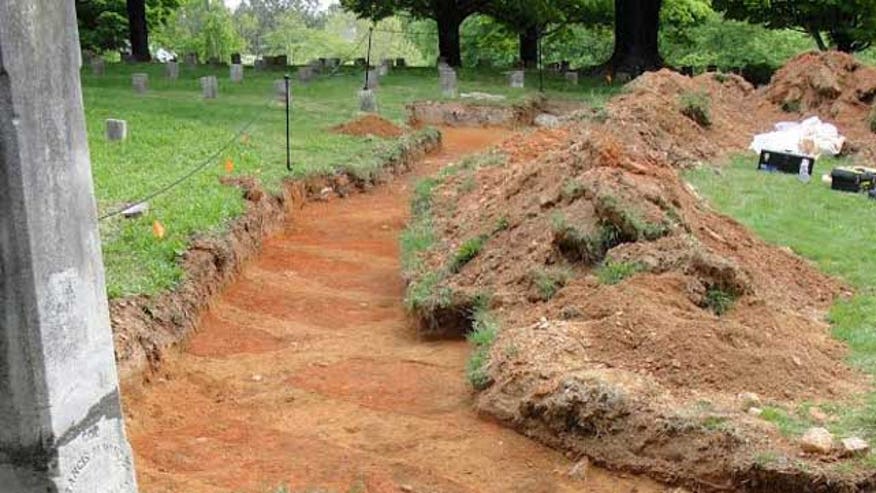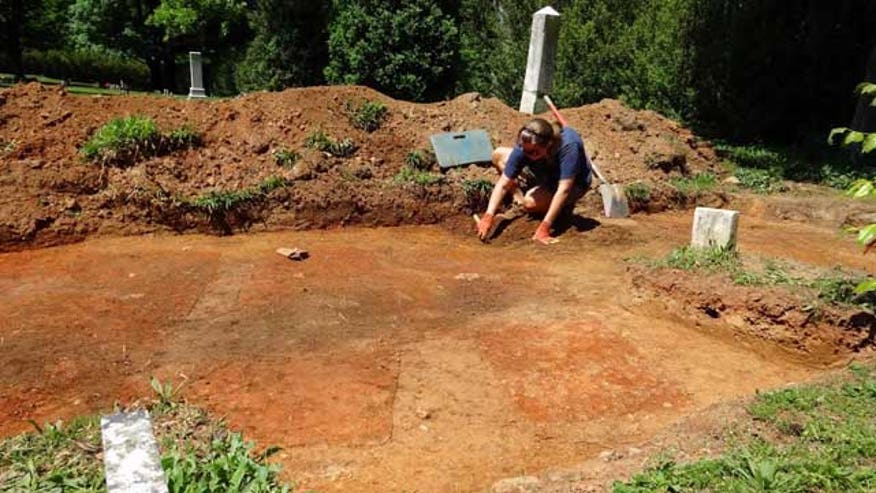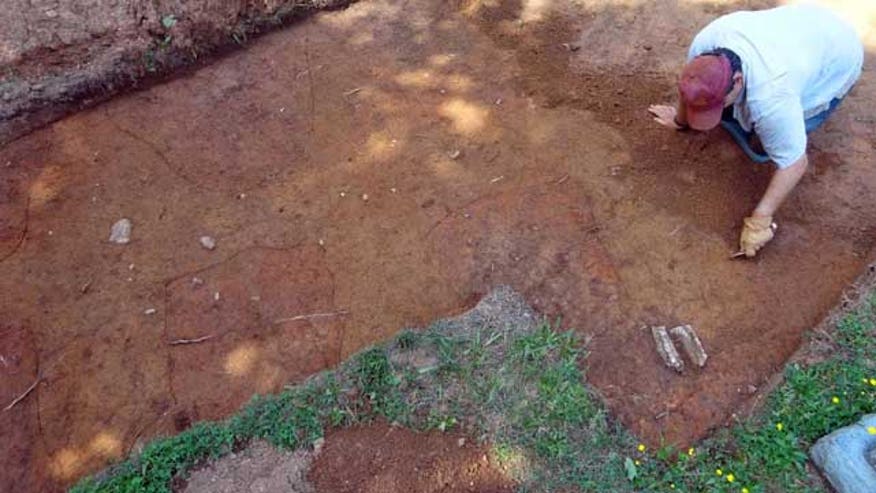Remains of 40 Confederate soldiers discovered in Virginia cemetery
"It's been very meaningful to us to find these spots, identify these soldiers and bring closure to families," said Ted Delaney, the cemetery's assistant director, who, along with a team of archaeologists, uncovered the exact resting place of some 40 Confederate soldiers as well as the plots where Union soldiers were once buried and later exhumed.
Delaney told FoxNews.com that, beginning in April, the team dug a 45-by-10-foot trench within "Yankee Square" at the cemetery where they found a mix of red and orange squares, which they determined were Confederate soldiers' graves. He said 35 to 40 graves were found during this latest search and that 50 were uncovered in the same area last year.
Delaney said he is now tasked with identifying each soldier's grave and giving it the tribute it deserves. "Our goal is to put a marker at each grave space to identify the soldier and note when he died and his military unit," said Delaney, who is optimistic about the project because, "the undertaker's notes are so detailed and complete."
He said that when all is done, about 80 Confederate soldiers will be properly identified. He noted that the remains of Union soldiers were exhumed and removed from the plot of land in 1866.
"This has been an incredible process of discovery," he said. "It’s always been very frustrating for those descendents who come to us because they can't find their ancestor's grave. Now we can bring some of them closure."
The task to identify and maintain the graves of Civil War soldiers at the cemetery began in April 2013. Delaney and his team are receiving an annual $2,500 grant from the Virginia Department of Historic Records Work to document unknown graves within "Yankee Square," which was first intended as a burial site for Union soldiers and then came to include Confederate soldiers -- many of whom died from diseases such as small pox.
Delaney's crew is not the first to uncover unidentified Civil War graves in recent years.
Sam Ricks, who works as graves registrar for the Sons of Confederate Veterans' Pennsylvania Division, has long been on a quest to restore the graves of America's bravest. Ricks and his team are responsible for uncovering unmarked graves at Mount Moriah cemetery, an estimated 380-acre historic graveyard straddling Philadelphia and Yeadon, Pa., and the state's largest -- where 2,300 Navy service members and Marines dating from the Revolutionary War to the War of 1812 all the way to the Korean and Vietnam wars are buried.
In 2007, Ricks received an unusual request, which led him to a discovery that was "like finding a needle in a haystack."
Ricks was approached by a descendent of Nathan Tiernon Walton, a cadet from the Virginia Military Institute who, along with 294 other cadets, fought the Battle of New Market in Virginia for the Confederate Army on May 15, 1864. The battle is well-known to Civil War historians because the small Confederate Army, which consisted largely of the teenage cadets from VMI, defeated the Union soldiers and forced them out of the Shenandoah Valley.
Walton later became estranged from his family when he left his wife and daughter in Baltimore to find work in Atlanta and later Philadelphia, according to Ricks.
"He was a recluse," Ricks said, "And no one ever knew what became of him."
It was long believed by the family that Walton was buried in Baltimore, alongside his wife. But that theory was discounted when Walton's great-grandson, Bill Banks, visited Loudon Park Cemetery in Baltimore and found no evidence Walton was buried there.
Banks was on a quest that began 100 years ago with his grandmother, Walton's daughter, who handed down a large cast iron Southern Cross of Honor grave marker to be placed at her father's grave if it was ever found.
It was later discovered that Walton died in Philadelphia during the Great Influenza Pandemic of 1918, leading Ricks to eventually find his unmarked grave on Memorial Day in 2008 at Philadelphia Memorial Park in Frazer, Pa.
In November 2008, Ricks, as well as descendents of Walton, were finally able to mark his grave 90 years after his death with the cross passed down by his daughter."I'm reminded of this case every Memorial Day," Ricks said. "Walton's daughter had handed down to generations a marker to be placed at his grave should it ever be found. And then we actually did it. We fulfilled her wish."
Delaney said he is now tasked with identifying each soldier's grave and giving it the tribute it deserves. "Our goal is to put a marker at each grave space to identify the soldier and note when he died and his military unit," said Delaney, who is optimistic about the project because, "the undertaker's notes are so detailed and complete."
He said that when all is done, about 80 Confederate soldiers will be properly identified. He noted that the remains of Union soldiers were exhumed and removed from the plot of land in 1866.
"This has been an incredible process of discovery," he said. "It’s always been very frustrating for those descendents who come to us because they can't find their ancestor's grave. Now we can bring some of them closure."
The task to identify and maintain the graves of Civil War soldiers at the cemetery began in April 2013. Delaney and his team are receiving an annual $2,500 grant from the Virginia Department of Historic Records Work to document unknown graves within "Yankee Square," which was first intended as a burial site for Union soldiers and then came to include Confederate soldiers -- many of whom died from diseases such as small pox.
Delaney's crew is not the first to uncover unidentified Civil War graves in recent years.
Sam Ricks, who works as graves registrar for the Sons of Confederate Veterans' Pennsylvania Division, has long been on a quest to restore the graves of America's bravest. Ricks and his team are responsible for uncovering unmarked graves at Mount Moriah cemetery, an estimated 380-acre historic graveyard straddling Philadelphia and Yeadon, Pa., and the state's largest -- where 2,300 Navy service members and Marines dating from the Revolutionary War to the War of 1812 all the way to the Korean and Vietnam wars are buried.
In 2007, Ricks received an unusual request, which led him to a discovery that was "like finding a needle in a haystack."
Ricks was approached by a descendent of Nathan Tiernon Walton, a cadet from the Virginia Military Institute who, along with 294 other cadets, fought the Battle of New Market in Virginia for the Confederate Army on May 15, 1864. The battle is well-known to Civil War historians because the small Confederate Army, which consisted largely of the teenage cadets from VMI, defeated the Union soldiers and forced them out of the Shenandoah Valley.
Walton later became estranged from his family when he left his wife and daughter in Baltimore to find work in Atlanta and later Philadelphia, according to Ricks.
"He was a recluse," Ricks said, "And no one ever knew what became of him."
It was long believed by the family that Walton was buried in Baltimore, alongside his wife. But that theory was discounted when Walton's great-grandson, Bill Banks, visited Loudon Park Cemetery in Baltimore and found no evidence Walton was buried there.
Banks was on a quest that began 100 years ago with his grandmother, Walton's daughter, who handed down a large cast iron Southern Cross of Honor grave marker to be placed at her father's grave if it was ever found.
It was later discovered that Walton died in Philadelphia during the Great Influenza Pandemic of 1918, leading Ricks to eventually find his unmarked grave on Memorial Day in 2008 at Philadelphia Memorial Park in Frazer, Pa.
In November 2008, Ricks, as well as descendents of Walton, were finally able to mark his grave 90 years after his death with the cross passed down by his daughter."I'm reminded of this case every Memorial Day," Ricks said. "Walton's daughter had handed down to generations a marker to be placed at his grave should it ever be found. And then we actually did it. We fulfilled her wish."




